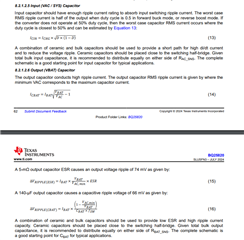Tool/software:
1) In some documentation I see the suggested minimum input and output capacitance is 160uF. If I go considerably lower than that, say 40uF for example what are the possible issues?
My system has 4 charging circuits for 4 batteries (so 4 BQ25280 chips). The batteries are hot swappable so I would like to to limit capacitance that is is attached to the battery. I could add a fet to handle this but I'm trying to avoid this due to space since I would need 4 copies. In my design I am not using the input fets or the battery fet and the batteries are isolated from the system during charging.
Vin is 18V
Battery 16.5V @ 9AH
Max charge current is 2.5A
2) Would the input capacitance need to increase by 4x since I have 4 chargers or would a 2x or something be adequate?
3) If I disconnect VAC using external opposing fets do I need to worry about any leakage current into the BQ25820 from other pins assuming the battery is connected?




